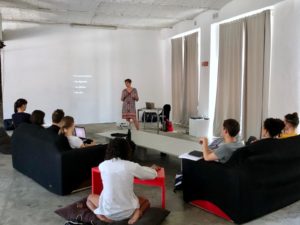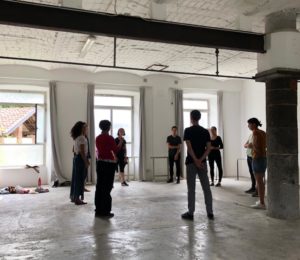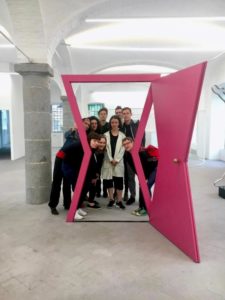Side by side for twenty years. UNIDEE’s 20th anniversary also marks twenty years of collaboration between University of Ideas and Fondazione Zegna, one of the most representative partnerships – obviously intertwined with Cittadellarte – not only because of its historicity, but also because of its shared local dimension. As part of the collaboration between the two Biellese organizations, for years Fondazione Zegna has in fact sponsored one of UNIDEE’s summer modules, whose key topic is the discovery of the territory and of Oasi Zegna; specifically, for the past two editions of the module visiting artists Andrea Caretto and Raffaella Spagna investigated the importance played by this naturalistic area in the Biellese territory from a social, cultural and landscape point of view. This year, the experience will focus on Trivero and on the social impact of the public art project by Fondazione Zegna, which – through this cultural programme – has financed artistic works and installations around town, to facilitate the access to contemporary art.
The module’s mentors, guests and residents
But let’s talk about the module started on 14th July, called Rituals of the contemporary. As inferred from the title, the residents will work on the theme of contemporary rituals, relying on the contribution of Fiamma Montezemolo, artist (MFA, San Francisco Art Institute) and anthropologist (Ph.D, Università degli Studi Orientali di Napoli), teaching in the Department of Cinema & Digital Media of the University of California in Davis. Anthropology and art, two apparently distant fields, are here closely connected: a meaningful binomial for Cittadellarte, which has always placed art in a virtuous relationship with every sector of the social fabric. To analyse in depth the contents of the module, guest Cristiana Giordano, professor of anthropology at Fiamma’s same university, will give her contribution on the key issues of the module. The activities will also involve journalist and curator Mariacarla Molè, who will write a report of the educational week. Rituals of the contemporary has been a huge success registering 110 requests for participation in the workshop, among which UNIDEE’s staff have selected six entries, a heterogeneous group for nationalities and professionalisms: Vitalij Strigunkov (1991, Lithuania), Elena Artemenko (1988, Russia), Antonio Ianniello (1979, Italy), Amy Pekal (1993, Poland/USA/The Netherlands), Eleonora Roaro (1989, Italy) and Lucandrea Baraldi (1991, Italy/The Netherlands).

The comment of Valerio Del Baglivo
“This year, – said to us Valerio Del Baglivo, UNIDEE’s visiting curator – together with Fiamma, we have decided to reason on the theme of new rituals, considering them in two different dimensions: in work and in leisure contexts. The ‘leisure’ section will be dedicated to analysing the social impact of Fondazione Zegna’s public art project in Trivero. The residents will therefore visit the Zegna factory, where they will try to find out if there exist rituals linked to the work of their employees. The artists will carry out their studies also in public spaces, in an attempt to understand whether and how local citizens interact with the installations part of the public art project. At the end of the module, the artists will develop a new ritual in the form of a performance: all will be revealed and presented in the course of their final restitution next Saturday”.
The module’s outline
Specifically, the residency proposes a reflection and an investigation on the concept of ritual, on its current meaning and its practice. “In the last few years, – we read in the module’s outline – many disciplines (religion studies, anthropology, philosophy, art, socio-biology) have approached the ritualistic and its role in making ‘visible’ a certain order in a specific context, in showing ‘the proven way of doing something’, which is the etymology of the word. As Catherine Bell says, ritualization is ‘a way of acting that is designed and orchestrated to distinguish and privilege what is being done in comparison to other, usually more quotidian, activities’. The ritual involves, in general, a series of choreographed practices based on images, words, activities, objects, symbols that are organized in a performative act. The ritualistic act requires whomever is involved to cross 3 phases: separation / threshold / aggregation (V. Turner). The initiated is pushed to ‘plunge’ in a sort of liminal phase in which he/she is immersed in an anti-structure/chaos (changing clothes, food, hallucination, dwelling in unusual spaces, loss of usual cultural references, etc.) for a definite period of time and in a specific space in order to re-emerge to a renewed status.


The participants will be invited to reflect on the ritual and envision their own performative act. They will do so by recreating a ‘rite of passage’, or ‘seasonal rite’, or ‘life event rite’, or ‘rite of exchange’ of their own choosing, through an investigation of the ritual in art, focusing the module on contemporary socio-cultural rites in the territory of Trivero and Oasi Zegna. In classic anthropology, the main understanding of the ritual is that the ‘liminal phase’ brings ultimately to an act of reintegration in a certain societal group. In contrast, our main question will be: could an art work make the liminal a more permanent condition and bring us to a new order instead of a preestablished one? We will work on the association of performance and ritual stressing their processual, indefinite dimension, and transformative possibilities, thus making the threshold of the liminal the main source of our creative acts”.

